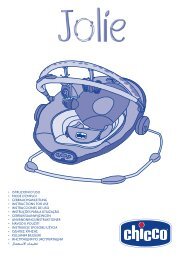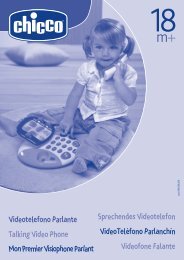Essential Digital Audio Baby Monitor - Chicco
Essential Digital Audio Baby Monitor - Chicco
Essential Digital Audio Baby Monitor - Chicco
You also want an ePaper? Increase the reach of your titles
YUMPU automatically turns print PDFs into web optimized ePapers that Google loves.
the power cord or plastic parts show signs of<br />
damage, do not use them and contact a qualified<br />
technician.<br />
- Do not leave mains adapters (1) plugged into<br />
the outlet when devices are not in use and/or not<br />
connected to the mains adapters (1).<br />
2.1.2 Modes of use - Switching on and<br />
Adjustment<br />
The child unit (primarily in transmitter mode)<br />
must be positioned about 1 - 1.5 metres from<br />
the child, on a flat, stable surface and with the<br />
microphone (7) directed toward the child.<br />
Attention: the transmitter, mains adapter and its<br />
power cord must be kept out of reach of children.<br />
• Child unit (primarily in transmitter mode) On/<br />
Off button (2).<br />
Press this button for about 3 seconds and the<br />
child unit will switch on. Do not press for too long,<br />
otherwise the child unit may not switch on. Press<br />
this button (2) again for about 3 seconds and the<br />
child unit will switch off.<br />
• Night light On/Off button (4)<br />
Press this button for about 3 seconds and<br />
the nightlight (3) will switch on steady and at<br />
minimum intensity.<br />
Do not press for too long, otherwise the nightlight<br />
(3) may not switch on.<br />
If during this operating mode, you press the<br />
nightlight On/Off button (4) once, the “Variable<br />
brightness nightlight” mode will be activated.<br />
Brightness will automatically vary from maximum<br />
level to minimum level.<br />
At the twelfth minute, nightlight brightness will<br />
remain fixed at minimum level.<br />
During the “Variable brightness nightlight”<br />
operating mode, if the nightlight On/Off button<br />
(4) is pressed once, light brightness will return<br />
steady at minimum level.<br />
If the nightlight On/Off button (4) is pressed<br />
again in this operating mode, the brightness<br />
variation cycle will begin again, starting from<br />
maximum level.<br />
Press the nightlight On/Off button (4) button<br />
again for 3 seconds and the nightlight will switch<br />
off, both in minimum, steady brightness and in<br />
“Variable brightness nightlight” mode.<br />
For energy savings, when the child unit (primarily<br />
in transmitter mode) is being powered via Alkaline<br />
batteries, the nightlight, if in minimum intensity<br />
and steady mode, switches off automatically 5<br />
minutes after the end of the ‘Variable brightness<br />
20<br />
nightlight” operating mode cycle.<br />
If the child unit (primarily in transmitter mode)<br />
is being powered via mains adapter (1), the<br />
nightlight will remain on in both modes until the<br />
button (4) is pressed again for 3 seconds.<br />
The nightlight can be switched on even when the<br />
child unit is off.<br />
2.1.3 Operating indicator lights<br />
- The power and link indicator light (5) supplies 3<br />
different pieces of information:<br />
- Indication that the device is on and properly<br />
connected to parent unit:<br />
the indicator light (5) will light up steady green.<br />
- Indication of loss or absence of link with the<br />
parent unit during operation:<br />
the indicator light (5) will light up green and<br />
begin to flash.<br />
As soon as the link with the parent unit is restored,<br />
the indicator light (5) will light up steady green.<br />
NOTE: when the child unit switches on, it<br />
searches for the channel to link with the parent<br />
unit; therefore the indicator light (5) will flash<br />
green until a link is established.<br />
-Indication of device off:<br />
the indicator light (5) will switch off.<br />
- The Alkaline battery status indicator light (6)<br />
supplies 2 different pieces of information:<br />
-Indication that Alkaline batteries are almost flat:<br />
the indicator light (6) will light up red and begin<br />
to flash.<br />
- Alkaline batteries charged or operation via<br />
mains adapter (1):<br />
the indicator light (6) will switch off.<br />
2.2 Parent unit (primarily in receiver mode)<br />
2.2.1 Power:<br />
Power via supplied rechargeable 3.7V 800mAh<br />
lithium-ion battery (13) or via 100-240V ~<br />
50/60Hz /6V 500mA (1) mains adapter<br />
ATTENTION. The charging of rechargeable<br />
batteries should only be done via the supplied<br />
mains adapter (1) and can be performed both if<br />
the parent unit is switched on and if the parent<br />
unit is off.<br />
In the event of power with mains adapter (1) or<br />
rechargeable lithium-ion battery charging:<br />
- insert the mains adapter jack (1) in the power<br />
connector (12) on the side of the unit.<br />
- verify that the voltage corresponds to the rating<br />
plat<br />
- in<br />
acce<br />
Wa<br />
- Th<br />
of s<br />
- P<br />
the<br />
dam<br />
tech<br />
- D<br />
the<br />
con<br />
2.2.<br />
Adj<br />
• Pa<br />
Off<br />
Pres<br />
pare<br />
long<br />
on.<br />
and<br />
A b<br />
unit<br />
• Lo<br />
- (3<br />
Pres<br />
sym<br />
leve<br />
the<br />
leve<br />
defa<br />
A be<br />
or d<br />
max<br />
will<br />
The<br />
dur<br />
has<br />
• V<br />
ON<br />
The<br />
tran<br />
or<br />
pos<br />
unit<br />
of a<br />
belo<br />
thre<br />
are











